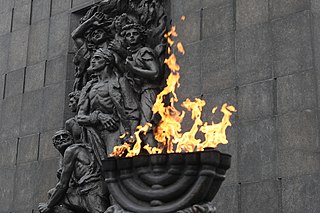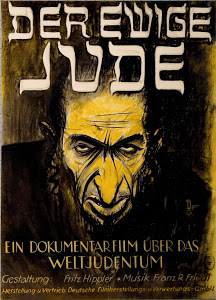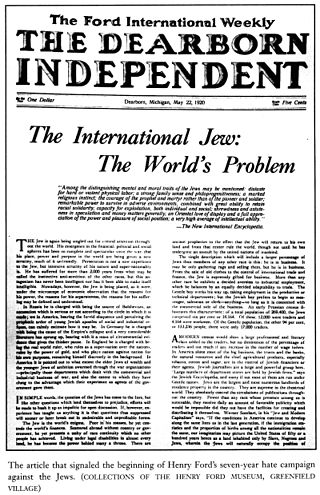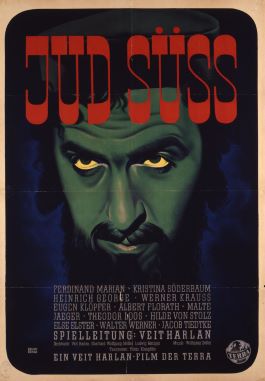The Eternal Jew (German : Der Ewige Jude) is the title of an antisemitic book published in 1937 by Franz Eher Nachfolger, the publishing house of the German Nazi Party (NSDAP). It comprises 267 photographs, each with a short caption denigrating Jewish people. [1] [2] [3]
Antisemitism is hostility to, prejudice towards, or discrimination against Jews. A person who holds such positions is called an antisemite. Antisemitism is a form of racism.

Judaism is an Abrahamic, monotheistic, and ethnic religion comprising the collective religious, cultural, and legal tradition and civilization of the Jewish people. It has its roots as an organized religion in the Middle East during the Bronze Age. Modern Judaism evolved from Yahwism, the religion of ancient Israel and Judah, by the late 6th century BCE, and is thus considered to be one of the oldest monotheistic religions. Judaism is considered by religious Jews to be the expression of the covenant that God established with the Israelites, their ancestors. It encompasses a wide body of texts, practices, theological positions, and forms of organization.

The Wandering Jew is a mythical immortal man whose legend began to spread in Europe in the 13th century. In the original legend, a Jew who taunted Jesus on the way to the Crucifixion was then cursed to walk the Earth until the Second Coming. The exact nature of the wanderer's indiscretion varies in different versions of the tale, as do aspects of his character; sometimes he is said to be a shoemaker or other tradesman, while sometimes he is the doorman at the estate of Pontius Pilate.

Ashkenazi Jews, also known as Ashkenazic Jews or Ashkenazim, are a Jewish diaspora population who formed in the Holy Roman Empire around the end of the first millennium CE. Their traditional diaspora language is Yiddish, which developed during the Middle Ages after they had moved from Germany and France into Northern Europe and Eastern Europe. For centuries, Ashkenazim in Europe used Hebrew only as a literary and sacred language until the revival of Hebrew as a common language in 20th-century Israel. Throughout their numerous centuries living in Europe, Ashkenazim have made many important contributions to its philosophy, scholarship, literature, art, music, and science.

The history of the Jews in Poland dates back at least 1,000 years. For centuries, Poland was home to the largest and most significant Ashkenazi Jewish community in the world. Poland was a principal center of Jewish culture, because of the long period of statutory religious tolerance and social autonomy which ended after the Partitions of Poland in the 18th century. During World War II there was a nearly complete genocidal destruction of the Polish Jewish community by Nazi Germany and its collaborators of various nationalities, during the German occupation of Poland between 1939 and 1945, called the Holocaust. Since the fall of communism in Poland, there has been a renewed interest in Jewish culture, featuring an annual Jewish Culture Festival, new study programs at Polish secondary schools and universities, and the opening of Warsaw's Museum of the History of Polish Jews.

The history of the Jews in Germany goes back at least to the year 321, and continued through the Early Middle Ages and High Middle Ages when Jewish immigrants founded the Ashkenazi Jewish community. The community survived under Charlemagne, but suffered during the Crusades. Accusations of well poisoning during the Black Death (1346–53) led to mass slaughter of German Jews and they fled in large numbers to Poland. The Jewish communities of the cities of Mainz, Speyer and Worms became the center of Jewish life during medieval times. "This was a golden age as area bishops protected the Jews resulting in increased trade and prosperity."

The Eternal Jew is a 1940 antisemitic Nazi propaganda film, presented as a documentary. The film's initial German title was Der ewige Jude, the German term for the character of the "Wandering Jew" in medieval folklore. The film was directed by Fritz Hippler at the insistence of Nazi Germany's Minister of Propaganda, Joseph Goebbels.

The Grand Anti-Masonic Exhibition was the name of an antisemitic exhibition that was opened on October 22, 1941 during World War II in Belgrade, the capital of the Nazi Germany-established Militärverwaltung in occupied Serbia.

Pruzhany is a town in Brest Region, Belarus, and the administrative center of Pruzhany District. Its population is about 18,500 people. The town is located at the confluence of the Mukha River and the Vets Canal, which give the start to Mukhavets River.

Michael Wolffsohn is a German historian. Wolffsohn was born in Tel Aviv, in what was then the British Mandate of Palestine and today is Israel. His parents were German Jews who fled in 1939.

The International Jew is a four-volume set of antisemitic booklets or pamphlets originally published and distributed in the early 1920s by the Dearborn Publishing Company, an outlet owned by Henry Ford, the American industrialist and automobile manufacturer.
The Franklin Prophecy, sometimes called the Franklin Forgery, is an antisemitic speech falsely attributed to Benjamin Franklin, warning of the supposed dangers of admitting Jews to the nascent United States. The speech was purportedly transcribed by Charles Cotesworth Pinckney during the Constitutional Convention of 1787, but was unknown before its appearance in 1934 in the pages of William Dudley Pelley's Silver Legion pro-Nazi magazine Liberation. No evidence exists for the document's authenticity, and some of Pelley's claims have actively been disproven.
Jewish assimilation refers either to the gradual cultural assimilation and social integration of Jews in their surrounding culture or to an ideological program in the age of emancipation promoting conformity as a potential solution to historic Jewish marginalization. In Israel, Hitbolelut is a derogatory term that mainly refers to the highly uncommon Jewish interfaith couples within it, which in turn gets local criticism for and marked as anti-Zionism (anti-Israel); especially when the coupling is done with the clashing nationalism of Arabs who are predominantly Muslims and of Palestinian ancestry – mainly because of the ongoing Arab–Israeli conflict, which began even prior to the declaration of independence by the State of Israel in 1948.

Jud Süß is a 1940 Nazi German historical drama and propaganda film produced by Terra Film at the behest of Joseph Goebbels. It is considered one of the most antisemitic films of all time. The film was directed by Veit Harlan, who wrote the screenplay with Eberhard Wolfgang Möller and Ludwig Metzger. The leading roles were played by Ferdinand Marian and Harlan's wife Kristina Söderbaum; Werner Krauss and Heinrich George played key supporting roles.
Secondary antisemitism is a distinct form of antisemitism which is said to have appeared after the end of World War II. Secondary antisemitism is often explained as being caused by the Holocaust, as opposed to existing in spite of it. One frequently quoted formulation of the concept, first published in Henryk M. Broder's 1986 book Der Ewige Antisemit, stems from the Israeli psychiatrist Zvi Rex, who once remarked: "The Germans will never forgive the Jews for Auschwitz." The term was coined by Peter Schönbach, a Frankfurt School co-worker of Theodor W. Adorno and Max Horkheimer, based on their critical theory.

Jews or Jewish people are an ethnoreligious group, nation or ethnos originating from the ancient Israelites and Hebrews of historical Israel and Judah. Jewish ethnicity, nationhood, and religion are strongly interrelated, as Judaism is the ethnic religion of the Jewish people, although its observance varies from strict to none.
A. James Rudin is an American rabbi noted for his work in inter-religious affairs.

The Eternal Jew was the title of an exhibition of antisemitism displayed at the Library of the German Museum in Munich from 8 November 1937 to 31 January 1938. The displays, with photographs and caricatures, focused on antisemitic canards falsely accusing Jews of Bolshevising Nazi Germany. It was best exemplified in the exhibition poster presenting an 'eastern' Jew wearing a kaftan and holding gold coins in one hand and a whip in the other. The exhibition attracted 412,300 visitors, over 5,000 per day.
Many Christians believe in a widespread conversion of the Jews to Christianity, which they frequently consider an end-time event. Some Christian denominations consider the conversion of the Jews imperative and pressing, and as a result, they make it their mission to proselytize among them.

This timeline of antisemitism chronicles the facts of antisemitism, hostile actions or discrimination against Jews as a religious or ethnic group, in the 20th century. It includes events in the history of antisemitic thought, actions taken to combat or relieve the effects of antisemitism, and events that affected the prevalence of antisemitism in later years. The history of antisemitism can be traced from ancient times to the present day.